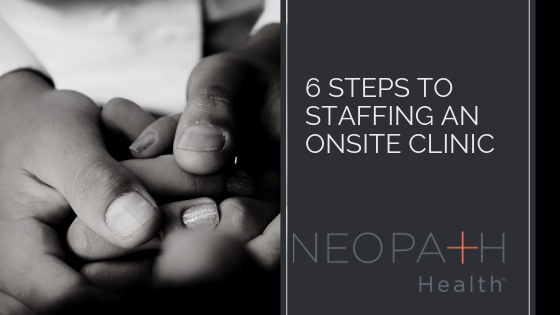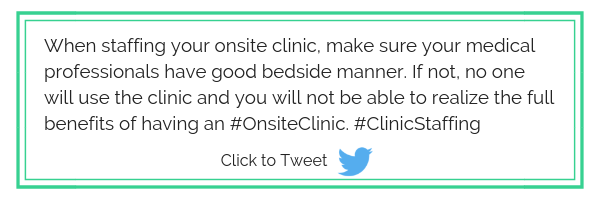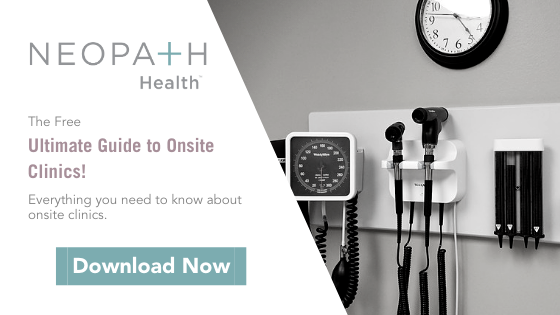One of the final steps prior to being able to open your onsite clinic to your employees is hiring your clinic staff. Although this may be one of the last pieces to fit into the puzzle, you'll want to begin planning for it in the early stages of implementation. Hiring can be a time-consuming process and there are many different options to consider when looking at staffing an onsite clinic. We've compiled a step-by-step guide to help make the process a bit more streamlined.

1. Select a Management Model
One of the first things you'll want to decide when implementing an onsite clinic is how you'd like to manage it. Do you want to DIY the entire thing, would you like to partner up with another company and share a clinic, would you like help from professionals? The hiring process, or at least your role in it, can be quite different depending on the management model you select. You have a few different options for how to manage your onsite clinic:
Employer-managed
With an employer-managed clinic model, your company will manage every aspect of the clinic. It's essentially the same way you manage the rest of your business. The staff will be your direct employees and you alone will manage all operational, HR, and compliance responsibilities. You may be able to hire an individual that has experience in clinical management to join your team directly and oversee the clinic functions.
Vendor-managed
The vendor-managed model allows you to hire a third-party company to operate your clinic. You still have the final say in how everything works, but the vendor will handle all of the leg-work and ongoing management responsibilities. This allows you to work with professionals that understand the ins and outs of the medical field and all of its intricate regulations. Vendors are able to assist with feasibility assessment, planning, building, and staffing, as well as ongoing management.
Provider-managed
This model is managed by hospitals or physician groups that are offering direct services to company. You may have less say in how this type of service operates, but it allows them to bring in their own staff or utilize their existing facilities to serve your employees.
2. Decide Which Kinds of Services Your Clinic Will Offer
In order to know what kind of professionals you'll need to look for when hiring, you'll first need to know exactly which services you will offer to your employees through your onsite clinic. Will you only treat worksite injuries? Will you offer primary care, physical therapy, are you going to include a pharmacy?

Some medical professionals may be able to cover more than one discipline, but for the most part, you'll need different experts for the various types of services you offer. Keep in mind, you can always start small and expand to additional services once things are up and running.
3. Discern What Type of Personnel You'd Like to Hire (MDs, RNs, NPs, Therapists, etc.)
Onsite clinic staffing practices vary from one onsite clinic to another. According to the National Association of Workplace Health Clinics though, over 60% of facilities are led by a Nurse Practitioner or Physician’s Assistant. This may take a bit of research and you will need to ensure that whomever you decide to go with has the right qualifications and level of experience to perform each specific service.
It is possible to run an on-site clinic without a physician on staff. However, it may be more difficult or more risky to dispense or prescribe medication, and you may need to set up a referral system for cases when a medical doctor is necessary.
4. Establish the Hours of the Clinic
Now that you know what types of healthcare professionals you need to find for your onsite clinic, you'll want to figure out how many hours you'll need to have each of them work. Will your clinic be open a couple of days a week, the entire work week, on weekends? Will it be open only during regular workday hours or will you have extended hours into the early morning or late evening?
Give this post a read if you have more questions on onsite clinics.
Understanding the amount of time the clinic will be open will allow you to comprehend how many individuals you'll need to bring on in order to cover all of the hours. You'll need to figure out if you will have people working part-time, full-time, on-call, or what mixture of hours will work best for full coverage. This is important so you can set hourly expectations with future employees up front and early in the hiring process.
5. Take Experience and "Bedside Manner" Into Account

Just like with any hire, it isn't necessarily about who can produce the most impressive resume. Healthcare is a very personal and intimate subject for each individual patient. You'll want to complete in-depth interviews with potential staff and ensure they are personable, easy to talk to, and able to communicate effectively and empathetically.
Make sure you are hiring individuals that your employees will enjoy interacting with because if no one uses the clinic due to subpar staff, you will not be able to realize the full benefits of having an onsite clinic. It's also important to understand if a potential hire has experience with patient groups that are similar to the demographics of your workforce.
6. Remember Staffing Concerns Don't Stop Once You've Completed Hiring
We've established the need to assess each potential candidate for the proper qualifications and also their ability to mesh well with your specific employee pool. An additional requirement for staffing your onsite clinic is to perform ongoing spot checks and surveying to ensure continued employee satisfaction with the clinic staff. If you notice a specific service isn't doing well, take a look at the staff performing that service, allow your employees opportunities and resources to complete provider-specific feedback, and pay close attention to what they say.
.png?width=433&name=NeoPath_2019_logo_2color%20(1).png)





